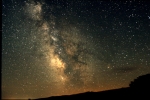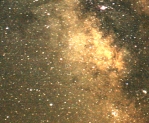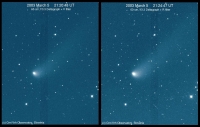| News 2002 - 2005 |
| NASA astronaut Russell L. Schweickart visited Crni Vrh Observatory (Oct. 2, 2005) | ||||
|
On September 8-11, 2005, former NASA astronaut Russell L. Schweickart
visited Slovenia together with his wife Nancy Ramsey.
He piloted Apollo 9's
lunar module in 1969 and served as a backup
commander for the first Skylab mission in 1973. He currently chairs the board of directors
for the B612 Foundation. Since we have common interest in NEO asteroids, he also visited Crni Vrh
Observatory.
His current interest is devoted to the NEO asteroids that are potentionally threatening our planet and plans to send the unmanned space mission trying to deflect such body and prevent it from hitting Earth. In October 2001, more than 20 like-minded engineers and astronomers, including few former and current astronauts gathered in the Johnson Space Center in Houston to discuss what they saw as the missing element in the space program - attention to the possibility of our planet being struck by a near Earth asteroid.
|
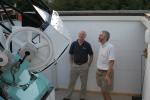
|
Russell L. Schweickart at Crni Vrh Observatory R. Schweickart and H. Mikuz during the inspection of the 60-cm Cichocki robotic telescope at Crni Vrh Observatory. In the course of PIKA search programe, 7 NEO asteroids were discovered so far with this telescope. Copyright © 2005 Crni Vrh Observatory.
|
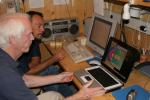
|
Inspecting virtual asteroid impact on Earth R. Schweickart and B. Dintinjana in the control room of Crni Vrh Observatory, inspecting the virtual asteroid impact on Earth and its consequences. See California for a simulation of a 2004MN4 impact generated tsunami in the Pacific Ocean and same object impacting in the Gulf of Mexico. Copyright © 2005 Crni Vrh Observatory.
|
|
In order to facilitate their work, they formed the B612 Foundation, a non-profit corporation named
after the home asteroid of the title character in Antoine de Saint-Exupery's The Little Prince.
Also they proposed to NASA a B612 Mission
that would be sent to appropriate NEO asteroid with well known orbit and either speed up the body by pushing it in
the direction of its orbital motion or slow it down by pushing in the opposite direction. Rather than
giving the asteroid a powerful shove, they proposed the asteroid-tug concept that would deliver
a gentle but constant pressure, causing a slight but large enough deflection of orbit. The space tug
would need to rendezvous with a target asteroid, attach itself to the surface and show its ability
to maneuver the object. Thus the goal of a B612 mission is to significantly alter the asteroid's
orbit in a controlled manner. If successfull, they would clearly demonstrate that the deflection of
small Solar System bodies from hitting Earth is possible.
|
||||
|
In a recent article published in Sept.-Oct. 2005
issue of American Scientist they stressed
the importance of such space mission, following a recent addition of the 330-m diameter
asteroid designated 99942 Apophis to the list of small bodies that have small but real chance
of striking the Earth.
|
| 2005 Perseids from La Palma, Canary Islands (Aug. 12, 2005) | ||||
|
During the night of 2005 Aug. 12-13, Crni Vrh Observatory team member Jure Skvarc set up his Canon
Digital Rebel DSLR camera and Peleng 3.5/8 mm fisheye lens on a fixed tripod atop the 2400m
elevation Roque de los Muchachos mountain on La Palma Island - one of the best observing places on
our planet. He obtained dusk to dawn long series of 30 second exposures, covering nearly the
whole sky. During the photo session, he recorded many meteors and two bright fireballs.
|
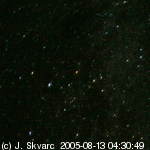
|
Perseid Fireball Animation of a -10 magnitude fireball from Aug. 13 at 3h38UT and its afterglow. Copyright © 2005 by J. Skvarc. |
| Transneptunian objects 2003 UB313 and 2003 EL61 (Aug. 4, 2005) | ||||
|
These objects were successfully imaged with 60-cm Cichocki Sky Survey Telescope
during the July 29 - Aug. 2 period. We took a series CCD exposures on each night and co-added them to obtain a single, long exposure
image of distant Solar System objects.
|
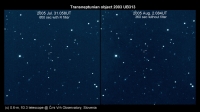
|
Transneptunian object 2003 UB313, so called 10th planet recently reported in
IAUC 8577
was successfully imaged on July 31 and Aug. 2 early morning sky with 0.6-m, f/3.3 remote robotic telescope, R+W
filters and CCD. The object was nearly 97 astronomical units from the Earth (current Sun-Pluto distance is 30 a.u.), slowly
moving toward the S-SW at only 11 arc sec/day. Image scale is 2.49 arc sec/pixel. Further details are displayed on images.
Copyright © 2005 by J. Skvarc & H. Mikuz, Crni Vrh Observatory.
|
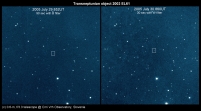
|
Transneptunian object 2003 EL61, recently reported in
IAUC 8577
was successfully imaged on two consecutive nights July 29-30, 2005 with 0.6-m, f/3.3 robotic telescope, B+W
filters and CCD. The object was nearly 52 astronomical units from the Earth, slowly
moving toward the SE at about 50 arc sec/day. Further details are displayed on images.
Image scale is 2.49 arc sec/pixel. Copyright © 2005 by J. Skvarc & H. Mikuz, Crni Vrh Observatory.
|
| Southern Milky Way with Nova Sagittarii 2005 No. 2 (July 22, 2005) | ||||
|
While staying on the Island of Cres (Croatia) for holidays, I took some wide field night sky scenes using a fixed tripod and
Canon EOS 20D DSLR camera. In spite of modest equipment (lack of motorized mount), I was able to obtain surprisingly good images of the
central region of our Milky Way Galaxy. By chance, the Nova Sagittarii 2005 No. 2 was also recorded 2.9 days
after discovery by William Liller in Chile (IAUC 8559).
|
|
Island of Cres is the largest in Adriatic sea but so far also relatively unpopulated, with only few smaller
tourist centers. The light pollution is consequently low. As soon as you move in the island countryside, the night sky
is very dark -- a good place for imaging the sky and the Southern Milky Way in particular. Perhaps, one of the darkest
places in Europe.
Some additional testing images, recently obtained with Canon 20D are collected in our
gallery |
| Discovery of NEO Asteroid 2005 FV2 at Crni Vrh Observatory (Mar. 18, 2005) | ||||
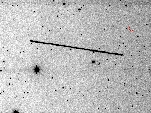
|
Click for animation of NEO asteroid 2005 FV2 discovery. Animation image was made by stacking three 25 second discovery frames taken on 2005 March 18.90 - 18.92UT with 60-cm, f/3.3 Deltagraph telescope and CCD. Image scale is 2.49 arc sec/pixel. Bright trail on the 3rd image is due to artificial satellite passing through the telescope field. Copyright © 2005 by S. Maticic and B. Dintinjana, Crni Vrh Observatory. |
|
On images taken by S. Maticic in the course of the Crni Vrh Asteroid and Comet Search
program PIKA on March 18, 2005 an asteroid with unusual motion was automatically detected.
After being posted on the NEO Confirmation Page, further measurements were obtained by
P. Birtwhistle (J95, Great Shefford) and S. Sposetti (143, Gnosca). They provided enough observations to determine basic
orbital parameters. With the semimajor axis of 2.05 AU, inclination of 19 degrees
and eccentricity of 0.71, this object belongs to the Apollo asteroid family. Estimated object diameter is ~500 m.
Closest approach to Earth was 0.265 AU on March 11, 2005.
Further observations and orbit details are in MPEC 2005-F28.
The NEO asteroid 2005 FV2 was discovered with the drift-scan along the declination circles technique that we regularly use on the 60-cm robotic telescope. The telescope was operated remotely and the new object was automatically found by Fitsblink software. Relevant links:
|
| Discovery of NEO Asteroid 2005 CR37 at Crni Vrh Observatory (Feb. 8, 2005) | ||||
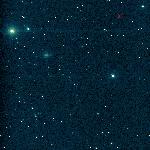
|
Click for animation of NEO asteroid 2005 CR37 discovery. Animation image was made by stacking three 25 second discovery frames taken on 2005 February 8.14 - 8.16UT with 60-cm, f/3.3 Deltagraph telescope and CCD. Image scale is 2.49 arc sec/pixel. Copyright © 2005 by H. Mikuz and B. Dintinjana, Crni Vrh Observatory. |
|
On images taken by H. Mikuz in the course of the Crni Vrh Asteroid and Comet Search
program on February 8, 2005 an asteroid with unusual motion was automatically detected.
The rate and direction of motion indicated that
the object does not belong to the main belt asteroids.
After being posted on the NEO Confirmation Page, further measurements were obtained by
observers worldwide. They provided enough observations to determine basic
orbital parameters. With the semimajor axis of 1.9 AU, inclination of 26 degrees
and eccentricity of 0.46, this object belongs to the Amor asteroid family. Estimated object diameter is ~900 m.
Closest approach to Earth is 0.063 AU on February 27, 2005.
Further observations and orbit details are in MPEC 2005-C32.
The NEO asteroid 2005 CR37 was discovered with the new drift-scan along the declination circles technique that we regularly use on the 60-cm robotic telescope. The telescope was operated remotely and the new object was automatically found by Fitsblink software. Relevant links:
|
| Discovery of NEO Asteroid 2005 CC37 at Crni Vrh Observatory (Feb. 6, 2005) | ||||
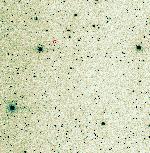
|
Click for animation of NEO asteroid 2005 CC37 discovery. Animation image was made by stacking three 25 second discovery frames taken on 2005 February 6.86 - 6.87UT with 60-cm, f/3.3 Deltagraph telescope and CCD. Image scale is 2.49 arc sec/pixel. Copyright © 2005 by S. Maticic and B. Dintinjana, Crni Vrh Observatory. |
|
On images taken by S. Maticic in the course of the Crni Vrh Asteroid and Comet Search
program on February 6/7 2005, an asteroid with unusual motion was automatically detected.
The rate and direction of motion (2.6o/ day in PA 113o) indicated that
the object does not belong to the main belt asteroids.
After being posted on the NEO Confirmation Page, further measurements were obtained by
H. Mikuz and other observers worldwide. They provided enough observations to determine basic
orbital parameters. With the semimajor axis of 2.2 AU, inclination of 6 degrees
and eccentricity of 0.56, this object belongs to the Apollo asteroid family. Estimated object diameter is ~200 m.
Closest approach to Earth was 0.0534 AU on January 27, 2005.
Further observations and orbit details are in MPEC 2005-C30.
The NEO asteroid 2005 CC37 was discovered with the new drift-scan along the declination circles technique that we regularly use on the 60-cm robotic telescope. The telescope was operated remotely and the new object was automatically found by Fitsblink software. Relevant links:
|
| Bright Fireball (Feb. 6, 2005) | ||||
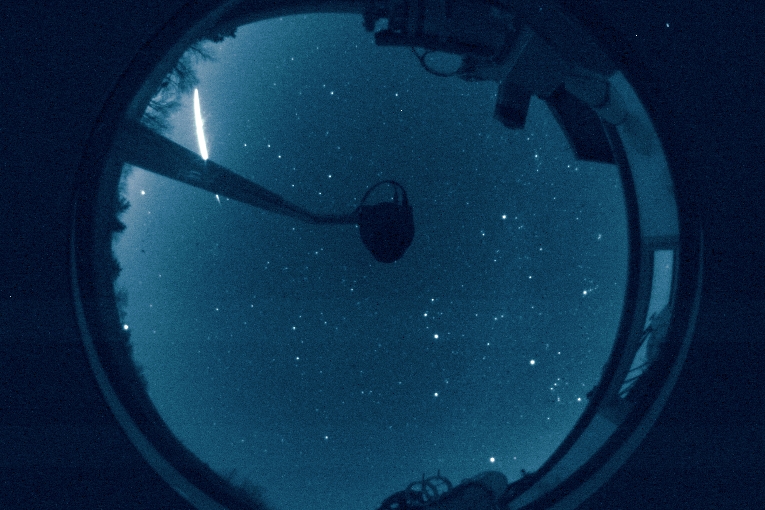
|
Bright Fireball Bright fireball of about magnitude -10 was recorded with the All-sky camera on 2005 Feb. 6. One minute exposure was centered at 22h32m40s UT. Trace of fireball afterglow was also recorded on next image taken one minute later. Several fireballs and other phenomena were recorded with this camera since we put it in regular operation in August 2004. Copyright © 2005 by H. Mikuz, Crni Vrh Observatory.
|
| Geminid Fireball (Dec. 12, 2004) | ||||
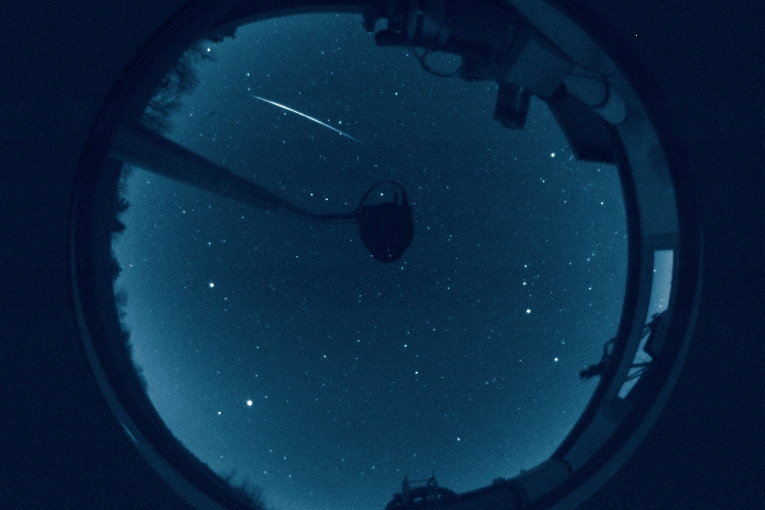
|
Geminid Fireball Bright fireball, belonging to Geminid shower was recorded with the All-sky camera in early morning of 2004 Dec. 12. One minute exposure was centered at 4h25m46s UT. Several fireballs and other phenomena were recorded with this camera since we put it in regular operation last August. Copyright © 2004 by H. Mikuz, Crni Vrh Observatory.
|
| Venus in conjunction with Jupiter (Nov. 5, 2004) | ||||
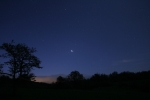
|
Venus in conjunction with Jupiter (Image Gallery) This scenic view of conjunction was obtained from Slovenia Karst region on early morning of November 5, 2004. Canon EOS 20D digital camera and 17-40 mm lens at f/4 was used. Exposure time was 30 seconds at ISO set to 400. Dark image of the same duration was automatically subtracted. Copyright © 2004 by H. Mikuz, Crni Vrh Observatory. Enter gallery ... |
| Discovery of NEO Asteroid 2004 RS109 at Crni Vrh Observatory (Sep. 10, 2004) | ||||
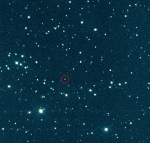
|
Click for animation of NEO asteroid 2004 RS109 discovery. Animation image was made by stacking three 25 second discovery frames taken on 2004 September 10.96 - 10.98UT with 60-cm, f/3.3 Deltagraph telescope and CCD. A numbered main belt asteroid 86034 is in the same field and marked with a green square. Note the difference in speed and direction of motion. Image scale is 2.49 arc sec/pixel. Copyright © 2004 by H. Mikuz and B. Dintinjana, Crni Vrh Observatory. |
|
On images taken by H. Mikuz in the course of the Crni Vrh Asteroid and Comet Search
program on September 10/11 2004, an asteroid with unusual motion was automatically detected.
The rate and direction of motion (3o/ day in PA 163o) indicated that
the object does not belong to the main belt asteroids.
After being posted on the NEO Confirmation Page, confirmation measurements were taken on the
Sep. 11 evening by S. Maticic and other observers worldwide. They provided enough observations to determine basic
orbital parameters. With the semimajor axis of 2.34 AU, inclination of 34 degrees
and eccentricity of 0.5, this object belongs to the Amor asteroid family. Closest approach
to Earth is on 2004 Sep. 16.5UT at the distance of 27 million km. Estimated diameter of this object is ~1 km.
Further observations and orbit details are in MPEC 2004-R61.
The NEO asteroid 2004 RS109 was discovered on the first night we used the new drift-scan along the declination circles technique on the 60-cm robotic telescope. It was operated remotely and the new object was automatically found by Fitsblink software. Relevant links:
|
| CARA Meeting, June 19-20th 2004 | ||||
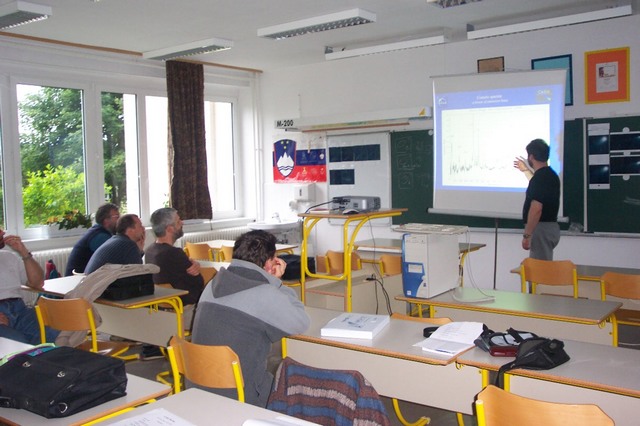
|
CARA Meeting, 2004 Some 15 comet observers from Italy, Hungary, Poland and Slovenia gathered on a two day CARA conference which take place at Crni Vrh elementary school. The aim of conference was discussion on how to improve the quality of comet observations by using new observational techniques (remote robotic telescopes, narrow band filters and various software tools). See conference programme for further details. On Sunday afternoon, participants visited nearby Crni Vrh Observatory where the new 60-cm robotic telescope is now in full operation. Part of telescope time is devoted also to comet observations. Unfortunately, evening remote observations were not possible due to bad weather. See also some nice pictures, taken during the conference. |
| Venus Transit, June 8th 2004 |
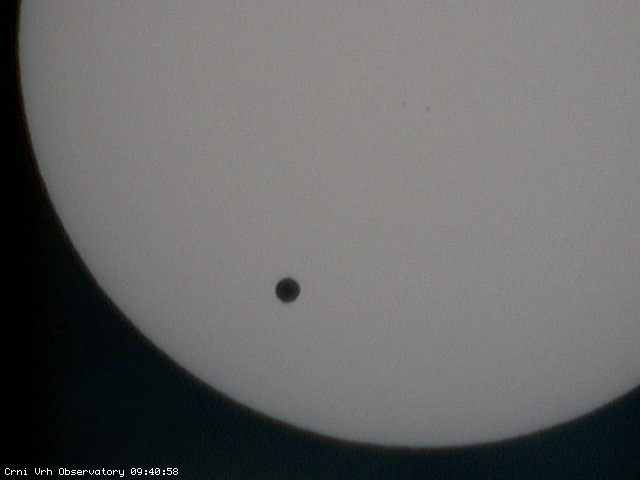
|
Venus Transit Live, June 8th 2004 Venus transit was successfully imaged with 500 mm, f/8 lens, webcam and solar filter. Video animation was prepared by using 360 images taken at 1 minute intervals. Time recorded on images is Central European Summer Time (UT+2h). North is up and East to the left. Copyright © 2004 by H. Mikuz, B. Dintinjana and S. Maticic, Crni Vrh Observatory, Slovenia. We prepared also public observation at the Crni Vrh Elementary School where B. Mikuz and J. Vales conducted observations with 15-cm Maksutov telescope and solar filter. |
|
You can look at image archive which
contain images at 10 sec intervals, starting from 5h30UT. The file name contain information on when
particular image was obtained. Thus image 74154.jpg was taken at 7h 41min 54 sec. Transit data for Crni Vrh Observatory
h m s
Fist contact 7:20:05.4
Second contact 7:39:40.1
Third contact 13:04:08.4
Fourth contact 13:23:22.4
|
| Discovery of NEO Asteroid 2004 FF29 at Črni Vrh Observatory (Mar. 28, 2004) |
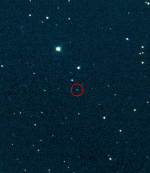
|
Click for animation of NEO asteroid 2004 FF29 discovery. Animation image is made by stacking three 30 second discovery frames taken on 2004 March 28.994 - 29.005UT with 60-cm, f/3.3 Deltagraph telescope and CCD. Image scale is 1.85 arc sec/pixel. Copyright © 2003 by H. Mikuž, S. Matičič and B. Dintinjana, Črni Vrh Observatory. |
|
On images taken by H. Mikuž in the course of the Črni Vrh Asteroid and Comet Search
program on March 28/29 2004, an asteroid with unusual motion was automatically detected.
The rate of motion (1.8 degree / day in PA ~250o) indicated that
this object does not belong to the main belt asteroids. Confirmation images were taken
next night by S. Maticic and object reported to the Minor Planet Center. After being posted
on the NEO Confirmation Page for a day, enough observations were provided to determine basic
orbital parameters. With the semimajor axis of 1.94 AU, inclination of 8 degrees
and eccentricity of 0.62 this object belongs to the Apollo asteroid family. Closest approach
to Earth was on 2004 Mar. 10.62UT at the distance of 25 million km. Estimated diameter of this object is ~1 km.
Further observations and orbit details are in MPEC
2004-F85. Relevant links:
|
| Discovery of NEO Asteroid 2003 SS214 at Črni Vrh Observatory (Sept. 26, 2003) |
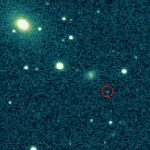
|
Click for animation of NEO asteroid 2003 SS214 discovery. Animation image is composed from three 30 second discovery frames taken on 2003 September 26.88UT with 60-cm, f/3.3 Deltagraph telescope and CCD. Image scale is 1.85 arc sec/pixel. Copyright © 2003 by S. Matičič and J. Skvarč Črni Vrh Observatory. |
|
On images taken by Stane Matičič in the course of the Črni Vrh Asteroid and Comet
Search program on 26 September 2003, an asteroid with unusual motion
was automatically detected. The direction and rate of motion (PA = 90 degrees at
almost 1.1 degree / day) indicated that this object does not belong to the main belt
asteroids. Confirmation images were taken next night by J. Skvar?and object reported to the
Minor Planet Center.
After being posted on the NEO Confirmation Page for a day, enough
observers provided additional position measurements to determine basic orbital
parameters. With the semimajor axis of 2.3 AU, inclination of 8 degrees and
eccentricity of 0.52 this object belongs to the Amor asteroid family. At the
closest approach to Earth it will be at the distance of 24 million km. Estimated
diameter of this object is 400 m. Relevant links:
|
| First NEO discovery at Črni Vrh Observatory (March 5, 2003) |
|
Fast moving object, crossing the field of Comet C/2001 RX14 (LINEAR) was found by J. Skvarc on 2003 March 5 in the
course of our sky survey program with 60-cm, f/3.3 Deltagraph telescope.
Due to rapid motion, the object left ~2 arc min trace on both 120 second images taken 4 minutes apart. NEO is just S-SW of the comet and
moves toward the SW direction. After beeing confirmed by several observatories it received the designation 2003 EM1. Preliminary
measurements indicate that this is a very fast rotating asteroid, probably first of this size with rotating period of less than 2 minutes.
It belongs to Aten type of asteroids which have their orbit entirely inside the Earth's. Further orbit details are published in
MPEC 2003-E28.
Image scale is 2.49 arc sec/pixel. Dark columns in the middle of frames are due to bad CCD cosmetics.
Copyright © 2003 by J. Skvarč, Črni Vrh Observatory, Slovenia.
Relevant links:
|
| First Light on the 60-cm Telescope (September 2, 2002) |
|
Early in the morning we obtained first images with the new
60-cm telescope.
We carefully assembled all telescope parts and on Sept 1st, the system was ready for first light. After the laser collimation procedure, we performed the Faucault test and adjusted the telescope back-focus to within 0.1mm off the ideal position. Then we put 1k x 1k CCD and took few images. The first one was out of focus and shows the telescope is well collimated. After some focus adjustment, we obtained second image with sharp stellar images accross the whole field. We slewed the telescope to M33 and took a 3-min unguided exposure with R filter. Again, stellar images remain pin-point, although the mount was not yet aligned and the telescope drive constants only roughly set. Since the CCD was not used for a few months, all images have lot of ice crystalls all over the frame and are unprocessed. We just want to demonstrate that the optics, mechanics and electronics performed well. Real images will follow soon. See also one minute CCD exposure of M15 globular cluster, using a 60-cm telescope and R filter. |
| 60-cm Telescope Near the Completion (May 13, 2002) |
|
Works on the construction of a 60-cm telescope are well in progress. The telescope optics
was ordered at Astrooptik Co. in August 2000 and delivered in April 2001. Technical solutions and project drawings were
completed early in 2001. Later, we switched our activity to observatory reconstruction. In August 2001,
we received servo motors and drive electronics. At the same time, work on the completion of control
electronics started. During November 2001 - March 2002, most of telescope parts were made in a local
workshop and on March 22, we started to assemble all parts together.
The upper ring, containing corrector and motorized focusing device was assembled first. On April 25th, the telescope servo drives were successfully tested for the first time. The most time consuming and rather difficult process was the making of motorized flaps that cover the mirror cage and protect it from moisture and dust. After all parts were assembled, the telescope was tested in a workshop once again on May 13, 2002. Mechanical and electronics tests passed well and the telescope was disassembled for painting. It will be installed at the Crni Vrh Observatory in June 2002. |
|
|
